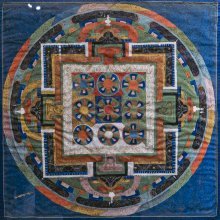Navagrahamandala, Navagrahamaṇḍala, Navagraha-mandala: 1 definition
Introduction:
Navagrahamandala means something in Hinduism, Sanskrit. If you want to know the exact meaning, history, etymology or English translation of this term then check out the descriptions on this page. Add your comment or reference to a book if you want to contribute to this summary article.
Images (photo gallery)
In Hinduism
Jyotisha (astronomy and astrology)
Source: Google Books: Studies in the History of the Exact Sciences (Astronomy)Navagrahamaṇḍala (नवग्रहमण्डल) (Cf. Navagraha) or simply Grahamaṇḍala refers to the “maṇḍala of nine planets”, according to the Āśvalāyanagṛhyapariśiṣṭa (2.3).—[Images of and offerings to grahas]—Instead of making the statues one can draw the figures representing grahas in a maṇḍala [i.e., navagrahamaṇḍala] (Cf. Yājñavalkyasmṛti 1.298). The figures to be drawn are not prescribed in Yājñavalkyasmṛti, but they seem to have been a common knowledge since almost all the gṛhya texts agree on the followingfigures: circle (Sun), square (Moon), triangle (Mars), arrow (Mercury), oblong (Jupiter), pentagon (Venus), bow (Saturn), winnowing basket (Rāhu), and triangular flag (Ketu).

Jyotisha (ज्योतिष, jyotiṣa or jyotish) refers to ‘astronomy’ or “Vedic astrology” and represents the fifth of the six Vedangas (additional sciences to be studied along with the Vedas). Jyotisha concerns itself with the study and prediction of the movements of celestial bodies, in order to calculate the auspicious time for rituals and ceremonies.
See also (Relevant definitions)
Partial matches: Mandala, Navagraha.
Full-text: Grahamandala.
Relevant text
No search results for Navagrahamandala, Navagrahamaṇḍala, Navagraha-mandala, Navagraha-maṇḍala; (plurals include: Navagrahamandalas, Navagrahamaṇḍalas, mandalas, maṇḍalas) in any book or story.
